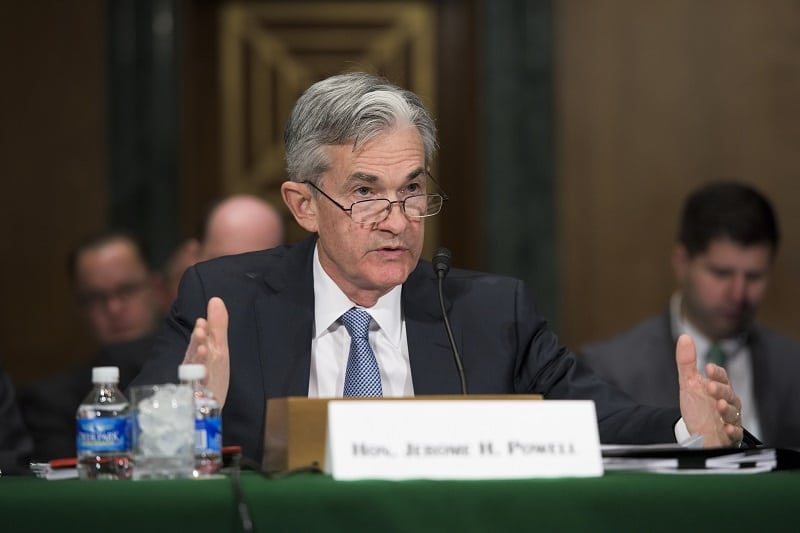A 75 basis points (bps) interest rate hike by the Federal Reserve cannot be ruled out after inflation came in hotter than expected last month.
The US consumer price index dipped back down to 8.3% in April after hitting a 40-year high of 8.5% in March. Analysts had predicted the headline rate would fall to 8.1%.
Although the headline rate appears to have peaked, markets had little to celebrate as the April readout surprised on the upside yet again.
An even bigger shock was the core rate, which strips out volatile food and energy prices, doubling from 0.3% in March to 0.6%.
The tech-heavy Nasdaq, which has fallen by over a quarter amid the growth sell-off, was down 0.5% by mid-morning on the East Coast, though the S&P 500 proved more resilient and was up 0.3% on the previous close.
Government bonds also sold off, with the two-year Treasury yield hitting 2.7%, while the longer-dated 10-year yield leapt to 3.02%.
‘Deceleration will be painstakingly slow’
Richard Carter, head of fixed interest research at Quilter Cheviot, says the latest readout shows “it is far too early to declare victory”. Though energy prices stabilised last month, they could rise further if the Ukraine war escalates, he notes.
“Furthermore, while it is hoped US inflation has peaked, other countries cannot say the same thing, and this has become a global problem.”
The full impact from the rise in commodity prices due to the war in Ukraine has not yet made its way into consumer prices, says Federated Hermes senior economist Silvia Dall’Angelo, meaning food and transport services will likely see further increases over the coming months.
Additionally, the labour market is tight, meaning wage pressures will remain sustained, she adds.
Seema Shah, chief strategist at Principal Global Investors, says April’s smaller than expected tumble is a warning sign “the deceleration is going to be painstakingly slow”.
“The focus will soon start shifting from where inflation peaked to where it plateaus, and we fear that it will plateau at an uncomfortably high level for the Fed,” Shah says.
See also: Rising yields prompt investors to re-think bond allocations
‘A couple more prints like this and 75bps rise may be back on the table’
The disappointing print piles even more pressure on the Fed to act aggressively. Earlier this month, the central bank raised its target rate by 50bps for the first time since 2000. But over the coming months, this may become the new normal.
Dall’Angelo expects back-to-back 50bps hikes in the June and July meetings.
“[April’s] inflation will do little to assuage stagflationary concerns in financial markets. Inflation will likely remain sticky in coming months, meaning that uncertainty about inflation developments and the Fed’s reaction function will linger, resulting in elevated market volatility.”
A 75bps increase is not out of the question either, despite chair Jay Powell ruling out such a steep hike.
“The hope was that April’s CPI print would quieten the debate around a 75bps Fed hike in the coming months. Unfortunately, that debate will remain alive and well for another month at least,” Invesco director of macro research Benjamin Jones says.
“A couple more prints like this and a 75bps rate rise may be back on the table,” Shah agrees.
“We expect headline inflation to only fade to 5.5% by year-end. With companies still displaying impressive pricing power, inflation expectations elevated, the labour market red hot and supporting strong wage growth, and shelter inflation still rising, the pressure on the Fed is going to remain intense.”
3% rate ‘makes a lot of sense’
Mike Contopoulos, director of fixed income at Richard Bernstein Advisors, says whether the Fed hike rates by 75bps is “almost irrelevant”.
“The big picture that people are missing, and possibly the Fed as well, is that the ultimate rate they are going to have to hike to in order to contain inflation … is probably significantly higher than the equity market, rates market and the Fed expect.”
The four key drivers of Treasury yields – inflation, economic growth, the size of the Fed balance sheet and the federal funds rate, currently between 0.75%-1%, are all suggesting “much higher rates,” Contopolous says.
“This is going to be a hiking cycle that lasts quite a while. Leading economic indicators, nominal GDP, they’re all supportive of a higher rate environment so 3% makes a lot of sense to us. We think we can go significantly higher from here.”
Falling goods inflation will ease pressures
Daniele Antonucci, chief economist & macro strategist at Quintet Private Bank, doesn’t think Powell will go back on his word and lift rates by 75bps in one go.
“Falling goods inflation and base effects will contribute to falling inflation pressures in the second half of the year, and absent of any new shocks in energy, for example, should lead to a lower headline figure by year-end or early 2023,” he says.
“Coupled with slowing growth momentum, we think the Fed will eventually adapt a more measured pace of tightening in order to avoid pushing the economy into recession.”
Dall’Angelo also expects to see inflation falling quickly next year as energy prices stabilise, global supply constraints ease and “crucially” a slowdown in demand.
“Over time, it is also possible that inflation will stabilise above the Fed’s 2% target, to the extent that the pandemic and the war in Ukraine catalysed structural changes in the labour market domestically and in supply chains globally.”










